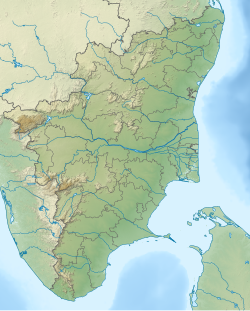
Back মহাবলীপুৰম স্মাৰকসমূহ Assamese মহাবলীপুরম স্মারকসমূহ Bengali/Bangla Tempelbezirk von Mahabalipuram German مجموعه تاریخی ماهابالی پورام Persian קבוצת המונומנטים במהאבליפורם HE Gruppo di monumenti presso Mahabalipuram Italian ಮಹಾಬಲಿಪುರಂನ ಸ್ಮಾರಕಗಳ ಸಮೂಹ Kannada महाबलिपुरममे रहल स्मारकसभक समूह MAI မဟာဘာလီပူရမ်ရှိ အထိမ်းအမှတ်အဆောက်အဦး အစုအဝေး Burmese महाबलीपुरममा रहेको स्मारकहरूको समूह Nepali
| UNESCO World Heritage Site | |
|---|---|
| 4 scenes at Mahabalipuram monuments 2.jpg | |
| Location | Mahabalipuram, Chengalpattu district, Tamil Nadu, India |
| Includes |
|
| Criteria | Cultural: (i), (ii), (iii), (vi) |
| Reference | 249 |
| Inscription | 1984 (8th Session) |
| Coordinates | 12°37′0″N 80°11′30″E / 12.61667°N 80.19167°E |
| Mahabalipuram Stone Sculpture | |
|---|---|
| Geographical indication | |
| Description | Sculptures in Mahabalipuram |
| Type | Handicrafts |
| Area | Mahabalipuram, Tamil Nadu |
| Country | India |
| Registered | 2017–18 |
The Group of Monuments at Mahabalipuram is a collection of 7th- and 8th-century CE religious monuments in the coastal resort town of Mahabalipuram, Tamil Nadu, India and is a UNESCO World Heritage Site.[1][2][3] It is on the Coromandel Coast of the Bay of Bengal, about 60 kilometres (37 mi) south of Chennai.[1]
The site has 40 ancient monuments and Hindu temples,[4] including one of the largest open-air rock reliefs in the world: the Descent of the Ganges or Arjuna's Penance.[1][5] The group contains several categories of monuments: ratha temples with monolithic processional chariots, built between 630 and 668; mandapa viharas (cave temples) with narratives from the Mahabharata and Shaivite, Shakti or Shaaktha and Vaishnava inscriptions in a number of Indian languages and scripts; rock reliefs (particularly bas-reliefs); stone-cut temples built between 695 and 722, and archaeological excavations dated to the 6th century and earlier.[3][6]
The monuments were built during the rule of the Pallava dynasty.[2][3][7] Known as the Seven Pagodas in many colonial-era publications, they are also called the Mamallapuram temples or Mahabalipuram temples in contemporary literature. The site, restored after 1960, has been managed by the Archaeological Survey of India.[8]
- ^ a b c Mamallapuram Archived 4 December 2022 at the Wayback Machine, Encyclopedia Britannica
- ^ a b James G. Lochtefeld (2002). The Illustrated Encyclopedia of Hinduism: A-M. The Rosen Publishing Group. p. 399. ISBN 978-0-8239-3179-8.
- ^ a b c "Group of Monuments at Mahabalipuram". UNESCO World Heritage Convention. United Nations Educational Scientific and Cultural Organization. Archived from the original on 4 November 2005. Retrieved 23 October 2012.
- ^ National Geographic (2008). Sacred Places of a Lifetime: 500 of the World's Most Peaceful and Powerful Destinations. National Geographic Society. p. 154. ISBN 978-1-4262-0336-7.
- ^ George Michell (1977). The Hindu Temple: An Introduction to Its Meaning and Forms. University of Chicago Press. pp. 131–134. ISBN 978-0-226-53230-1.
- ^ Group of Monuments at Mahabalipuram, Dist. Kanchipuram Archived 29 May 2018 at the Wayback Machine, Archaeological Survey of India (2014)
- ^ "Advisory body evaluation" (PDF). UNESCO.org. Archived (PDF) from the original on 9 October 2022. Retrieved 23 October 2012.
- ^ World Heritage Sites - Mahabalipuram Archived 17 May 2018 at the Wayback Machine, Archaeological Survey of India (2014)




